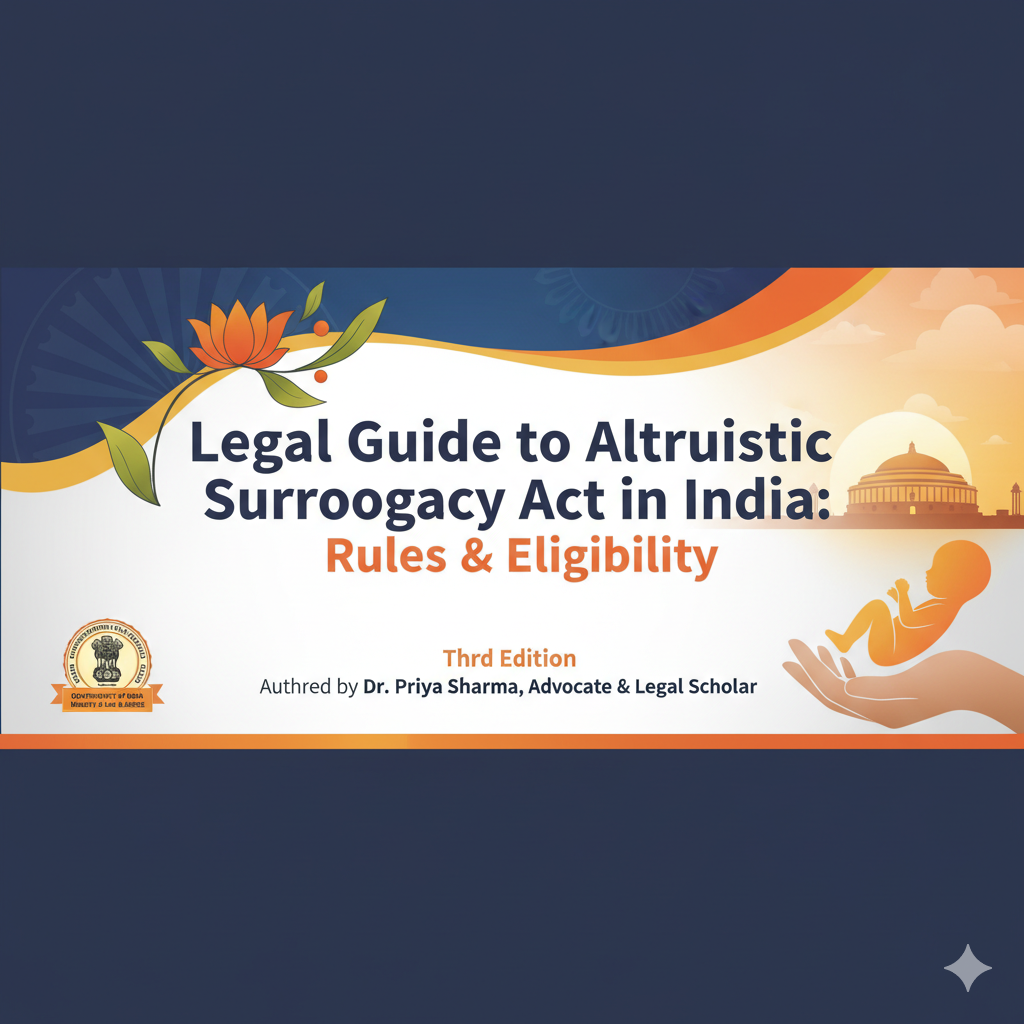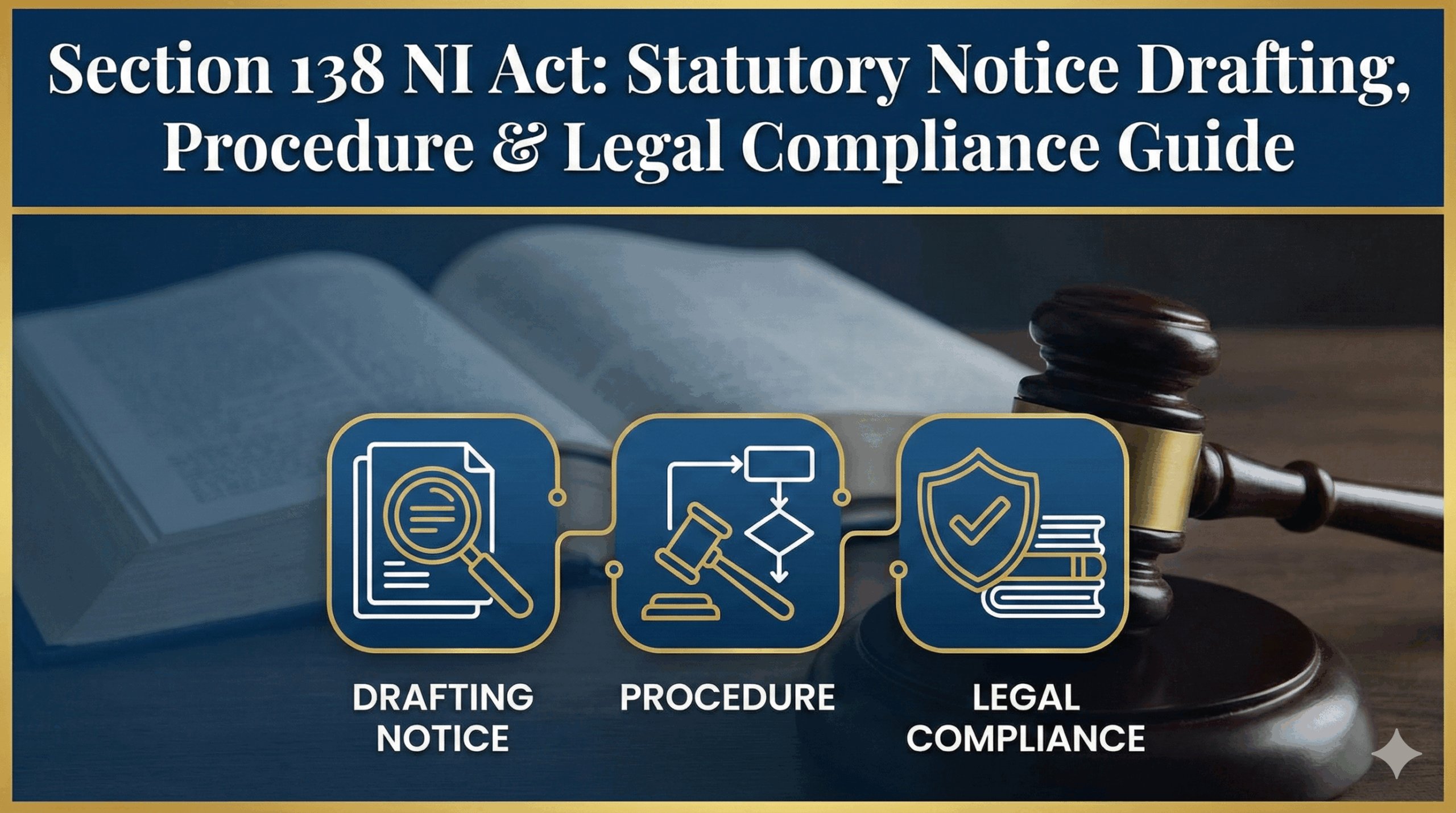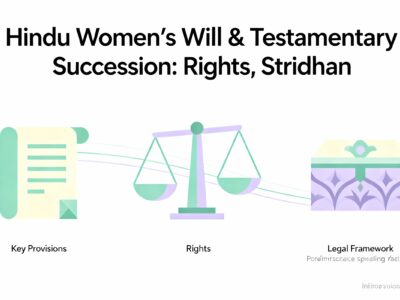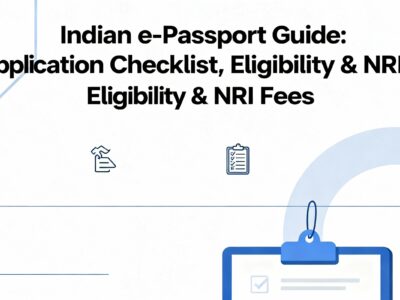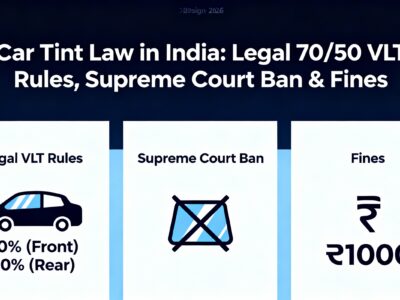The legal framework governing surrogacy in India underwent a monumental transformation with the enactment of the Surrogacy (Regulation) Act, 2021, and the Assisted Reproductive Technology (Regulation) Act, 2021. These laws established a new era, permitting only altruistic surrogacy while completely banning commercial arrangements. For intending parents and potential surrogates, navigating this complex legal landscape is crucial. This comprehensive guide, updated for 2025, breaks down the entire process—from eligibility criteria for couples and single women to the mandatory legal agreements, the rights of the child, and the severe penalties for non-compliance.
Family Law & Reproductive Rights
A Comprehensive Legal Guide to Altruistic Surrogacy in India
Navigating the Surrogacy (Regulation) Act, 2021 and recent 2024 amendments.

The Legal Landscape of Surrogacy in India: An Overview
The legal framework governing surrogacy in India underwent a monumental transformation with the enactment of two interconnected pieces of legislation: the Surrogacy (Regulation) Act, 2021, and the Assisted Reproductive Technology (Regulation) Act, 2021. Both laws came into force on January 25, 2022, creating a comprehensive and stringent regulatory regime for a field that had previously operated in a legal vacuum.
Prior to these Acts, India had become a global hub for surrogacy, driven by a lack of specific laws, advanced medical facilities, and lower costs. This unregulated environment, however, gave rise to significant ethical concerns, including the exploitation of surrogate mothers and the abandonment of children. The new legislation was designed to address these issues by establishing clear standards and safeguarding the rights of all parties involved.
The Paradigm Shift: Prohibiting Commercial Surrogacy
The most significant change is the complete prohibition of commercial surrogacy. This is defined as any arrangement that includes a monetary benefit exceeding basic medical expenses and insurance for the surrogate. This ban represents a fundamental policy reversal, prioritizing ethical imperatives over the economic benefits of the formerly $2 billion industry.
Defining Altruistic Surrogacy: The Only Legal Path
With the prohibition of commercial arrangements, the law now permits only altruistic surrogacy. In this model, the surrogate mother receives no financial compensation. The intending parents are legally obligated to cover all medical expenses and provide a mandated insurance policy. This is the sole legal pathway to surrogacy in India.
Altruistic vs. Commercial Surrogacy: Key Differences
| Feature | Altruistic Surrogacy (Legal) | Commercial Surrogacy (Banned) |
|---|---|---|
| Compensation | No monetary payment. Only medical expenses and insurance coverage are permitted. | Includes monetary benefit or reward (in cash or kind) beyond medical expenses. |
| Legal Status | The only legally permitted form of surrogacy in India since January 2022. | Strictly prohibited and classified as a criminal offense. |
| Motivation | Based on compassion and a desire to help an infertile couple or woman. | Based on a contractual agreement for financial gain or profit. |
| Relationship | Surrogate must be a willing woman, often a close relative of the intending couple. | Could be an unrelated individual, often sourced through an agency. |
Eligibility for Intending Parents: Who Qualifies?
The Surrogacy (Regulation) Act, 2021, establishes a highly restrictive set of eligibility criteria. These rules frame surrogacy as a medical last resort rather than a broad reproductive choice.
The primary group eligible for surrogacy under the Act is a legally married heterosexual couple, who must meet the following stringent conditions:
- Citizenship: Both partners must be Indian citizens.
- Marital Duration: Legally married for a minimum of five years.
- Age Brackets: The female partner must be between 23-50 years, and the male partner between 26-55 years.
- Medical Necessity: Must possess a "Certificate of Essentiality" proving a medical condition that necessitates gestational surrogacy.
- No Surviving Child: No surviving child, with a compassionate exception for a child who is mentally or physically challenged or suffers from a life-threatening disorder.
Explicit Exclusions: Who Cannot Opt for Surrogacy
The law is as notable for who it excludes as for who it includes. The following groups are explicitly barred from pursuing surrogacy in India:
- Foreign Nationals, NRIs, and OCI cardholders.
- Single Men.
- LGBTQ+ individuals and unmarried/live-in couples.
The Surrogate Mother: Eligibility and Protections
The Act places immense focus on the surrogate mother, establishing a robust framework of eligibility criteria to ensure her well-being and a comprehensive set of legal rights to protect her throughout the process.
Strict Eligibility Criteria
- Must be a married woman between 25 and 35 years old.
- Must have at least one biological child of her own.
- Can only be a surrogate once in her lifetime.
- Cannot use her own eggs (must be gestational surrogacy).
- Must obtain certificates of medical and psychological fitness.
Legal Rights and Safeguards
While the law is founded on altruism, it establishes strong non-monetary rights and legal protections for the surrogate:
- Informed Consent: Her written and informed consent is paramount.
- Right to Withdraw: She can withdraw consent at any point before embryo implantation.
- Mandatory Insurance: A 36-month health insurance policy must be provided by the intending parents.
- Control Over Abortion: Her written consent is required for any termination of the pregnancy.
The Surrogacy Agreement: A Legally Binding Contract
Before the Magistrate's Court can issue an order on parentage, a formal, legally enforceable surrogacy agreement must be drafted and executed between the intending parents and the surrogate mother. This document is the cornerstone of the legal process, outlining the duties and obligations of each party. It must be drafted by a lawyer and witnessed appropriately.
Essential Clauses in the Agreement
While specific details may vary, every agreement must explicitly state the following:
- A declaration from the surrogate mother that her participation is purely altruistic and she will receive no monetary compensation.
- An undertaking from the intending parents to cover all medical, nutritional, and travel expenses related to the pregnancy and post-partum recovery.
- A commitment from the intending parents to not abandon the child under any circumstances, including congenital abnormalities.
- Details of the 36-month insurance policy provided for the surrogate mother.
- A clause confirming that the surrogate mother has the right to make decisions regarding her health, including the choice of medical procedures, with the exception of abortion unless medically necessary or mandated by law.
The Insurance Mandate: A Closer Look
A critical safeguard for the surrogate mother is the mandatory insurance coverage that must be procured by the intending parents. This is not a general health policy but a specific insurance product designed to cover all potential complications arising from the surrogacy process.
Coverage Requirements
The insurance policy must meet two key requirements as per the Act:
- Duration: The policy must be valid for a period of 36 months (3 years). This extended duration is designed to cover the entire pregnancy period as well as a significant post-partum phase, ensuring any long-term health issues linked to the pregnancy are covered.
- Scope of Coverage: It must cover all complications arising from the pregnancy and the delivery process. This includes, but is not limited to, emergency C-sections, post-partum depression, gestational diabetes, hypertension, and any other medical issues that can be reasonably linked to the surrogacy. The amount of coverage is not specified in the Act but is expected to be substantial enough to cover treatments at reputable private hospitals.
The Procedural Gauntlet: A Step-by-Step Legal Process
The path to altruistic surrogacy in India is a meticulous, multi-stage process designed to ensure that only genuinely eligible and fully compliant parties can proceed. This infographic outlines the key stages.
Step 1 & 2: Consultation & Counseling
The journey begins at a registered clinic for medical assessment. Both intending parents and the surrogate undergo mandatory legal and psychological counseling.
Step 3, 4, & 5: Regulatory Approval
Obtain a "Certificate of Medical Indication" from the District Medical Board, then apply to the "Appropriate Authority" for "Certificates of Essentiality and Eligibility".
Step 6: Court Order for Parentage
Before any medical procedure, the intending parents must petition a Magistrate's Court for a pre-emptive "order of parentage and custody," legally establishing them as the child's parents.
Step 7 & 8: Agreement & Medical Procedure
A legally binding surrogacy agreement is executed. Only then can the IVF and embryo transfer procedure begin at the registered clinic.
Step 9 & 10: Birth and Final Legalities
After the child's birth, the baby is handed over as per the court order. The birth certificate is issued directly with the names of the intending parents.
The Rights of the Child: Ensuring Legal Parentage and Protection
The Act is unequivocally child-centric. A child born through a valid surrogacy procedure "shall be deemed to be the biological child of the intending couple." This powerful legal fiction is non-negotiable and automatic. The child is entitled to all the rights and privileges of a natural child, including inheritance. Furthermore, the law criminalizes the abandonment of the child for any reason, including disabilities or gender.
The Regulatory Framework: Governance and Oversight
To enforce the comprehensive rules, the government has established a multi-tiered regulatory structure to ensure uniform application of the law across India.
Hierarchy of Surrogacy Regulation
National Surrogacy Board (NSB)
Advises central government, formulates policy & code of conduct.
State Surrogacy Boards (SSBs)
Oversees state-level implementation and enforcement.
"Appropriate Authority"
Handles day-to-day enforcement, clinic registration, and issuance of certificates.
Role of ART Clinics and Medical Procedures
All surrogacy procedures must be conducted at clinics registered under the Assisted Reproductive Technology (Regulation) Act, 2021. These clinics are heavily regulated and have specific legal obligations.
Key Responsibilities of Registered Clinics:
- Counseling: Provide comprehensive counseling to the intending parents and the surrogate about the risks, benefits, and legal implications.
- Record Keeping: Maintain meticulous records of all procedures, including gamete sources, treatment cycles, and outcomes for a minimum of 10 years.
- Ethical Conduct: Ensure that the number of embryos transferred is in line with medical guidelines to avoid multiple pregnancies, and that sex selection is strictly prohibited.
- Confidentiality: Uphold the privacy of all parties involved in the process.
Prohibitions, Offenses, and Penalties
The Act is a criminal statute with severe penalties for non-compliance. Violations are treated as serious criminal matters and are classified as cognizable, non-bailable, and non-compoundable.
Penalties Under the Surrogacy (Regulation) Act, 2021
Recent Developments and Critical Perspectives
Analysis of the 2024 Amendment: The Donor Gamete Exception
A crucial development is the Surrogacy (Regulation) Amendment Rules, 2024. A 2023 rule had banned all donor gametes. The 2024 amendment now permits the use of one donor gamete (either egg or sperm) if a District Medical Board certifies it's a medical necessity. However, the child must be genetically related to at least one intending parent, so using both donor egg and sperm is still prohibited.
Ongoing Legal Challenges and Criticisms
The Act faces substantial criticism and legal challenges before the Supreme Court of India. The core criticisms revolve around its restrictive and allegedly discriminatory nature, including:
- The exclusion of single men, unmarried couples, and the LGBTQ+ community.
- The argument that a complete ban on commercial surrogacy undermines a woman's bodily autonomy and may drive the practice underground.
- Certain criteria, like specific age brackets, being criticized as arbitrary.
A Global Perspective: How India Compares
India's altruistic-only, highly restrictive model stands in contrast to the diverse legal approaches to surrogacy worldwide. Understanding these differences highlights the unique nature of the Indian legal framework.
Surrogacy Laws: India vs. Other Nations
| Country | Legal Model | Eligibility for Intending Parents |
|---|---|---|
| India | Altruistic only; strictly regulated. | Married Indian heterosexual couples; single Indian women (widows/divorcees) in specific age groups. |
| United Kingdom | Altruistic only; agreements are unenforceable. | Open to couples and single individuals, irrespective of sexual orientation. Parentage transferred via a post-birth "parental order". |
| Canada | Altruistic only; commercial surrogacy is a criminal offense. | Generally open to all, including single individuals and same-sex couples, though provincial laws vary. |
| USA | Varies by state; some permit commercial surrogacy (e.g., California), while others prohibit it (e.g., Michigan). | Highly dependent on state law. "Surrogacy-friendly" states are often open to international, single, and LGBTQ+ parents. |
Frequently Asked Questions (FAQ)
1. Can a close relative, like a sister or sister-in-law, be a surrogate?
Yes, absolutely. The law encourages altruistic arrangements, and a close relative is often the most suitable and willing person to act as a surrogate, provided she meets all the other eligibility criteria (age, marital status, has her own child, medical fitness, etc.).
2. What happens if the intending couple separates or divorces during the surrogacy process?
This is a complex situation. The court order for parentage is issued before the embryo transfer, legally binding both individuals in the couple as the parents. They cannot disown the child post-divorce. The surrogacy agreement should ideally contain clauses that address custody and financial responsibility in such a scenario.
3. What if the surrogate mother miscarries?
A miscarriage is a tragic medical event. Legally, the intending parents are responsible for all medical costs associated with the miscarriage and the surrogate's recovery. The Act allows for up to three attempts at the surrogacy procedure for a given surrogate. A miscarriage would count as one of these attempts.
4. Are there any costs other than medical bills and insurance?
While the arrangement is altruistic, intending parents must cover all reasonable expenses. This can include the surrogate's nutritional supplements, maternity clothing, travel costs for medical appointments, and compensation for any lost wages if she is employed and needs to take time off for medical reasons. These must be actual expenses and not a disguised fee.

